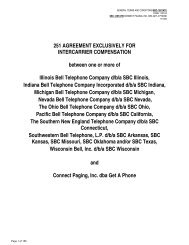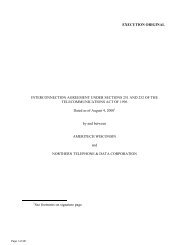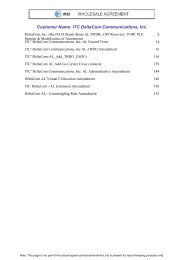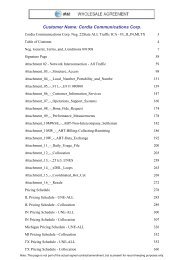Optical Telecommunications, Inc.
Optical Telecommunications, Inc.
Optical Telecommunications, Inc.
You also want an ePaper? Increase the reach of your titles
YUMPU automatically turns print PDFs into web optimized ePapers that Google loves.
Version: 2Q05 Standard ICA<br />
07/06/05<br />
Attachment 3<br />
Page 10<br />
third party tandems such as an ICO tandem or other CLEC tandem. BellSouth<br />
originated traffic may, in order to prevent or remedy traffic blocking situations, be<br />
transported on a separate single one-way trunk group terminating to OTI.<br />
However, where OTI is responsive in a timely manner to BellSouth’s transport<br />
needs for its originated traffic, BellSouth originating traffic will be placed on the<br />
two-way Local Traffic trunk group carrying ISP-Bound Traffic and IntraLATA<br />
Toll Traffic. The LERG contains current routing and tandem serving<br />
arrangements. The two-way trunk group architecture is illustrated in Exhibit D.<br />
4.10.2.4 Supergroup Architecture. In the supergroup architecture, the Parties’ Local<br />
Traffic, ISP-Bound Traffic and IntraLATA Toll Traffic and OTI’s Transit Traffic<br />
are exchanged on a single two-way trunk group between OTI and BellSouth to<br />
provide Intratandem Access to OTI. This trunk group carries Transit Traffic<br />
between OTI and ICOs, IXCs, other CLECs, CMRS providers that have a MPB<br />
arrangement with BellSouth, and other network providers with which OTI desires<br />
to exchange traffic. This trunk group also carries OTI originated Transit Traffic<br />
transiting a single BellSouth Access Tandem destined to third party tandems such<br />
as an ICO tandem or other CLEC tandem. BellSouth originated traffic may, in<br />
order to prevent or remedy traffic blocking situations, be transported on a separate<br />
single one-way trunk group terminating to OTI. However, where OTI is<br />
responsive in a timely manner to BellSouth’s transport needs for its originated<br />
traffic, BellSouth originating traffic will be placed on the Supergroup. Other trunk<br />
groups for operator services, directory assistance, emergency services and<br />
intercept must be established pursuant to the applicable BellSouth tariff if service is<br />
requested. The LERG contains current routing and tandem serving arrangements.<br />
The supergroup architecture is illustrated in Exhibit E.<br />
4.10.2.5 Multiple Tandem Access (MTA) Interconnection<br />
4.10.2.5.1 Where OTI does not choose access tandem interconnection at every BellSouth<br />
Access Tandem within a LATA, OTI must utilize BellSouth’s MTA<br />
interconnection. To utilize MTA OTI must establish an interconnection trunk<br />
group(s) at a minimum of one (1) BellSouth Access Tandem within each LATA as<br />
required. BellSouth will route OTI’s originated Local Traffic, ISP-Bound Traffic<br />
and IntraLATA Toll Traffic for LATA wide transport and termination. OTI must<br />
also establish an interconnection trunk group(s) at all BellSouth Access Tandems<br />
where OTI NXXs are homed as described in Section 4.2.1 above. If OTI does not<br />
have NXXs homed at any particular BellSouth Access Tandem within a LATA and<br />
elects not to establish an interconnection trunk group(s) at such BellSouth Access<br />
Tandem, OTI can order MTA in each BellSouth Access Tandem within the LATA<br />
where it does have an interconnection trunk group(s) and BellSouth will terminate<br />
OTI’s Local Traffic, ISP-Bound Traffic and IntraLATA Toll Traffic to End Users<br />
served through those BellSouth Access Tandems where OTI does not have an<br />
interconnection trunk group(s). MTA shall be provisioned in accordance with<br />
BellSouth’s Ordering Guidelines.<br />
CCCS 111 of 261
















